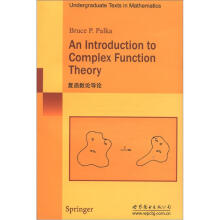复函数论导论(英文版)

目 录内容简介
The book at hand has its origins in and reflects the structure of a course that I have given regularly over the years at the University of Texas. The course in question is an undergraduate honors course in complex analysis. Its subscribers are for the most part math and physics majors, but a smattering of engineering students, those interested in a more substantial and more theoretically oriented introduction to the subject than our normal undergraduate complex variables course offers, can usually be found in the class. My approach to the course has been from its inception to teach it in everything save scope like a beginning graduate course in complex function theory. (To be honest, I have included some material in the book that I do not ordinarily cover in the course, this with the admitted purpose of making the book a suitable text for a first course in complex analysis at the graduate level.) Thus, the tone of the course is quite rigorous, while its pace is rather deliberate. Faced with a clientele that is bright, but mathematically less sophisticated than, say, a class of mathematics graduate students would be, I considered it imperative to give students access to a complete written record of the goings-on in my lectures, one containing full details of proofs that I might only sketch in class, the accent there being on the central idea involved in an argument rather than on the nitty-gritty technicalities of the proof. I also deemed it wise to provide the students with a generous supply of worked-out examples appropriate to the lecture material. Since none of the textbooks available when I started teaching the course had exactly the emphasis I was looking for, l began to compile my own set of lecture notes. It is these notes that have evolved into the present
book.
book.
比价列表







 缺书网
缺书网 扫码进群
扫码进群